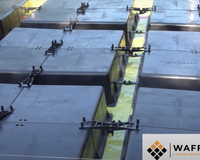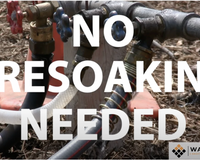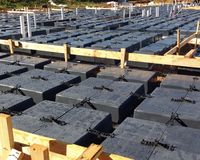Texas is home to the hottest housing market in the country. As more people call the Lone Star State their home, many are surprised to learn Texas is #1 in foundation failures. It’s not uncommon to find cracks in the foundations, walls, and brick of homes built in Texas. All of which can lead to expensive repairs and a reduction in the value of a home.
So, why do foundation failures happen more in Texas, and is there anything you can do about it? Here’s everything you need to know about building a reliable foundation in Texas.
What causes foundation problems in Texas? 
A large percentage of land in Texas is filled with fertile black soil, which is excellent for agriculture, but not for construction. The Blackland Prairies spans 6.1 million hectares from San Antonio to the Red River north of Dallas. This region contains a high content of expansive clay soil that expands when exposed to moisture.
The upward movement caused by soil expansion is known as slab heave, or “upheaval”. Slab heave can produce differential pressures across a foundation, making it prone to failure and slowly causing damage to a home. Common Texas house foundation issues include cracks in the walls and brick, leaning chimneys, sticking doors and windows, water damage, and more.
As this soil moves through the seasons and is exposed to wet and dry weather, the movement caused by expansion can cause severe damage to a home’s foundation. Eventually, this damage can result in foundation failures that require expensive and lengthy repairs. So, what can you do to prevent foundation problems in Texas?
Welcome to Post Tensioned Foundations
After about a decade of research and experimentation, the Post Tension Institute was formed in 1976 to standardize the design and installation of Post Tension foundations in the State of Texas. The concept was so successfully adopted that this type of foundation is now being used throughout the United States (and other countries) in an attempt to address the issues with expansive soils. Because this type of foundation design is so much more affordable than the popular “pier and beam” foundation, it has become the foundation of choice for expansive soils. Unfortunately, a Post Tension foundation does not completely eliminate movement in the foundation or the potential of a foundation failure... hence the reason Texas is #1 in foundation failures and foundation repair.
How to prevent foundation problems in Texas
If you’re building on expansive soil, you have a few options for preventing foundation problems. When choosing the best choice for avoiding foundation issues, you will need to balance the cost and efficiency of each technique. Here’s what you need to know to choose the best process for your project.
Soil moisture conditioning
Soil conditioning is the process of improving soil conditions for construction. Many techniques qualify as soil conditioning, such as select fill, compaction, and water injections. When these techniques are applied to expansive clay soils, they make conditions safer for construction and help to prevent future damage to a foundation.
Before opting for soil conditioning, there are a few things you should know. Prices can vary according to the size of your project, local climate, and a variety of environmental factors like topography, vegetation, and traffic. In most cases, soil conditioning will cause unexpected delays and cost increases for a project.
Soil conditioning is effective at reducing the potential for soil movement, but it won’t eliminate it completely. Even more stable soils have a certain amount of potential movement. If the prospect of movement is not acceptable or desirable, other alternatives must be employed.
The Wafflemat System: A Superior Post Tension Design
Instead of conditioning your soil, you can use a foundation made to withstand the differential movements caused by soil expansion. The Wafflemat System is an above-ground Post Tension foundation, unlike your typical concrete slab. Wafflemat is designed with beams in a grid pattern to increase the strength of the foundation. Between the beams are Waffle Boxes that allow soils to move and expand without exerting stress on the foundation.
Wafflemat protects against foundation damage and can make the construction process much smoother. This system doesn’t require digging for interior trenches, long-term soil maintenance, or changes to your home’s design. Wafflemat is the best solution for avoiding foundation issues for homes all across Texas.
Get a geotechnical soil report
The best way to protect against foundation issues in Texas is to learn about your soil. Working with a geotechnical engineer to obtain a soil report will tell you all you need to know to prevent foundation problems on expansive soils.
What’s included in a soil report? A report provides information on surface and subsurface conditions, engineering recommendations, elevation, drainage, and expert analysis and interpretation of the data. The more you know about your soil, the more potential solutions you can use to mitigate soil movement, ease the construction process, and prevent foundation issues.
Texas’s soil conditions vary based on environmental, historical, and geographic factors. This means that even when nearby sites have ideal soil conditions, you should always individually test the site you will be working with. This will help you prevent any foundation issues by ensuring that your foundation is properly supported for long-term use.
Learn more about preventing foundation failures
If you’re struggling to find a solution to building on bad soil, don’t worry. Although building a foundation in Texas may come with a few extra challenges, you can still build a home without encountering any issues. Learn more about preventing foundation failures by reading our articles by engineers in the field, with answers to essential foundation questions and first-hand knowledge of building on expansive soils.






